| Documenting Tribal knowledge: |
SAKTI, an NGO was established in 1985 by Dr. Sivarama Krishna, who got doctorate degree in 1982 on "Tribal Knowledge Systems", from Osmania University. Sarada Devi joined SAKTI in 1987. |
| |
| Conserving the Forests: |
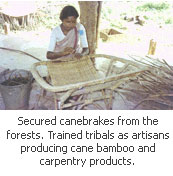 Office of the Dist.Forest Offier, Kakinada Dvn. Office of the Dist.Forest Offier, Kakinada Dvn.
Kakinada,
E.G.Dist
MEMO Rc.No.18945/85.L.
Sub:- Issue of cane wood to the Tribal beneficiaries - through ITDA
- Rampachodavaram - reg.
Ref:- Project Officer, ITDA, R.Chodavaram D.O.No.T5/1136/85 Dt.25.6.85.
A copy of the reference cited is herewith enclosed. The Forest Range Officer is directed to give necessary instructions to the section officers and forest guard to guide the beneficiaries in cutting and transporting the cane.
Sd/ Dist.Forest Officer, Kakinada
|
| |
Community Forest Management
“NGO-supported community based conservation: NGOs are supporting community struggle for conservation of their resources in two ways: one is to fight the attempts of entrenched classes to do any more damage and the second is to devise positive solutions for conservation. For example, Sakti is a federation of 23 community groups who have been protecting their forests for more than 10 years, much before the advent of JFM, and, because of their strength, are in a position to consolidate their conservation efforts by utilizing JFM provisions.” page no.98 |
| -Aravind Khare Community based conservation in India, Sage publications, New Delhi 1998. |
| |
Tribals trek to save Godavari delta forests
Sakti generated over 300 complaints about trees that had been cut or marked for felling in violation of rules. Felling Rules and Silvicultural practices stipulated as follows. Only matured or dying trees were to be felled. Jeelugu (Caryota urens) palm, trees yielding minor forest produce like tamarind or cane brakes, creepers were not to be touched. A gap of 20 meters from a stream. Cutting a tree was not allowed if it would disturb the canopy. Complaints citing instances of violation of the above rules saved many trees".
It is to Sakti's credit that it has documented such violations and anomalies extensively, motivated people in many villages to report such violations to prevent tree cutting in the first place and fought legal battles right up to high court.
|
| - C Lokeswara Rao - Times of India April 30, 1991 |
| |
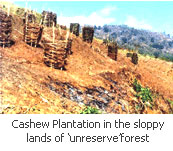 While tribals are prosecuted for cultivating in reserve forests, the lands abutting the reserve boundary are classified as ‘unreserved’. The forest department was wielding a de facto control on these lands. SAKTI in collaboration with ITDA (Integrated Tribal Development Agency) had taken up cashew plantations in these lands in 1985. Revenue department issued titles to the beneficiaries and demolished the myth of ‘unreserved’. While tribals are prosecuted for cultivating in reserve forests, the lands abutting the reserve boundary are classified as ‘unreserved’. The forest department was wielding a de facto control on these lands. SAKTI in collaboration with ITDA (Integrated Tribal Development Agency) had taken up cashew plantations in these lands in 1985. Revenue department issued titles to the beneficiaries and demolished the myth of ‘unreserved’. |
| |
 The 1986 Godavari floods and the flash floods to hill streams in the cyclone of 1990, motivated SAKTI to take up disaster management/ preparedness measures and also started working on conservation of forests and environment as it realised that deforestation is one of the main causes for floods and the damages. The 1986 Godavari floods and the flash floods to hill streams in the cyclone of 1990, motivated SAKTI to take up disaster management/ preparedness measures and also started working on conservation of forests and environment as it realised that deforestation is one of the main causes for floods and the damages. |
| |
| Stopped the state-supported deforestation by plywood industries, mining leases and timber contractors in East Godavari district through PIL (Public Interest Litigation). |
| |
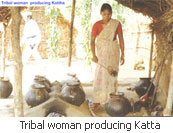 Restored the rights of tribals to get khair trees for kattha production offered to private merchants by forest department in Khammam and Karimnagar districts . Restored the rights of tribals to get khair trees for kattha production offered to private merchants by forest department in Khammam and Karimnagar districts .
In 1988 State government taken a policy decision to allot kattha trees to tribals.
In 1991 government invited private parties in certain districts for the allotment
The High Court suspended the allotment to private parties and directed the government to stick to the policy.
The government issued an order confirming the policy.
The kattha industries approached the court. Court directed that the government order is final. |
| |
(1997) 8 Supreme Court cases 191
Samata Vs. ... Appellant
State of A.P.and others ... Respondent
Hyderabad Abrasives & Minerals (P) Vs.... Appellant
State of A.P.and Others ... Respondent
Hyderabad abrasives & minerals (p) ltd. Along with 6 others lost the case against the Sakti in High court. Filed appeal in Supreme Court. See Para No.3,7,237 in the above judgement.
|
| |
The A.P.Forest Development Corporation Limited which is an undertaking of Government of Andhra Pradesh also constitutes a ‘person’ Since the A.P.Forest Development Corporation Limited, is not expressly exempted from the operation of A.P.Scheduled Areas Land Transfer Regulation 1959.
- Commissioner of Tribal Welfare to Dist.Collector, Khammam, Roc.No.1186/94/TRI/Rly.dt.19.5.1994.
|
| “In scheduled area, Government can transfer land for public purpose. Samatha vs. State of Andhra Pradesh, AIR 1997 SC 3297.”
- Andhra Pradesh Forest Laws, Page No.387, 2nd Edition 2000-2001, Asia Law House – By A.Kishan.
|
SAKTI forced the government to implement the instructions of Chief Secretary (27-10-‘89) to cancel the mining leases to non-tribals in Scheduled area. The contention of SAKTI that ‘person includes govt’ was upheld by High Court of A.P. in 1993. The Government concluded that the undertakings of government of A.P. also constitutes a person and instructed district Collector, Khammam to evict A.P. Forest Development Corporation holding cashew plantations in the scheduled area of that district. The intervention of Samatha, another NGO in this case brought APMDC (Andhra Pradesh Mineral Development Corporation – a state government undertaking) into the picture. The Supreme Court allowed alienation of land for government corporations. But tribals of Khammam forced the government to distribute these plantations held by APFDC (1600 acres) in ’99.
 |
| APFDC Ltd. – Sale of Cashew usufruct by A.P.Forest Development Corporation Limited – Formation of Co-operative of Tribals for sale of Cashew usufruct at Naramvarigudem Cashew Plantations in Khammam District – Orders – Issued. Environment Forests science and technology (S&T) Dept. G.O.Rt.No.523 dt.1.12.99. |
| |
| Resettlement & Rehabilitation: |
| |
| SAKTI is suing the Singareni Collieries, a public sector enterprise, to comply with the directions on rehabilitation in the above Supreme Court case. |
W.P. No. 11970 of 2004
SAKTI Vs. Union of India |
|
Direct the respondents to prepare a Resettlement and Rehabilitation Package for the Project Affected Families of Khairguda Open Cast Project of Bellampalli region of Adilabad District of the 7th respondent in the light of the National Policy of Resettlement and Rehabilitation for project Affected Families 2003 and the decision of the Hon’ble Supreme Court reported in AIR 1997 SC 3297 and implement the same within a time frame and pass such other orders as this Hon’ble court deem fit and proper in the circumstances of the case.
|
| |
| In March 1995, the High Court responding to the petition filed by SAKTI directed the state govt that permission of govt of India is mandatory to fell the trees, much before similar orders of Supreme Court in T.N.Godavarman case of 96. |
Forest – Supply of Forest raw material to M/s Godavari Plywoods Limited, as per the commitment given to BIFR – Orders – Issued, Environment, Forests, Science & Tech. (For.III) Dept. G.O.MSNo.66 dt.24.4.1996.
Relief Granted by AP High Court: (1033&1034/95)(direction dt.6-9-95) “The learned counsel for the petitioner submit that as per the provisions of the forest conservation act sanction of the Central Government is mandatory for felling trees.
Direction to the Dt forest officer Kakinada (R4) to approach the competent authorities for the grant of necessary permission for the supply of the raw material.”
|
| |
| High Court directed the government not to proceed with any activity regarding Bauxite mining in Visakhapatnam district without obtaining necessary clearance and disposed the case stating the agreement entered with Zindal South West Holdings Private Limited is inoperative. SAKTI also contested that the order of state government ot alienation of land to state corporations such as APMDC is against the procedures (consultation with Tribal Advisory Council and National Commission for Scheduled Castes & Scheduled Tribes) laid down in V Schedule and the Constitution. The high court did not respond to this prayer. |
WRIT PETITION NO. 1571 OF 2006
ORDER Dated, 20-06-2006 |
….. till the required permission is obtained by the State Government in terms of Section 2(2) of the Act as also environment clearance is granted by the competent authority, the agreement entered into between respondent No.1 and respondent No.7 shall not be implemented.
|
| |
The state government introduced new CrPC in the scheduled areas at the instance of Supreme Court. The Court incorporated the government order in their judgement. But, the government passed the order without consulting TAC and National Commission for Scheduled Castes & Scheduled Tribes. SAKTI challenged this lapse in the apex court. |
| |
| SAKTI invoked the prevention of SC&ST atrocities act against the atrocities committed by police on the tribals fighting for their land in West Godavari district. The Court directed to approach the Commission in the state. This Commission has no powers on par with the above act i.e., to appoint a special officer. SAKTI challenged the order in the apex court. |
| |
| SAKTI was NGO member in the expert committee convened by Government of Andhra Pradesh at the instance of Supreme Court of India in 1997 to define "Forests". The CEC of Supreme Court directed the State government to submit fresh estimates of "Forest" being submerged under Indira Sagar (Polavaram) dam. (A. No. 944 in A. No. 839, SAKTI Vs Govt of A.P.) |
G.O.Ms.No.1, EFS& T (For1), Dt.10-1-1997
The following are the members of the Expert Committee:
1. R.P.Bahadur, IFS (Retd)
2. M.D., APSRAC
3. Director, NRSA (National Remote Sensing Agency)
4. Secretary to Commissioner Land Revenue (CLR)
5. Commissioner, Tribal Welfare,
6. Sivaramakrishna, Sakti
7. K.Subba Rao, IFS, Chief Conservator of Forests, Member Convenor |
| |
| Obtained Stay Orders from High Court of A.P. against the circular of Inspector General of Forest for eviction of tribals from the ‘forests’ in Oct’2002. In India High Court of A.P. only issued orders against eviction. Conducting trainings for NGOs and tribals in identifying forest boundaries through “Flagstone Cairns” “Masonry Cairns” “Earthern Cairns” “Rough Stone Cairns” and “Intermediate Cairns”, Forest map reading and in understanding the procedures for claiming the rights to their occupation of forests. |
| “A land mark order was passed by the Supreme Court on March 1995 in which the States of Maharashtra and Madhya Pradesh were directed to decide about the people’s claims in the light of 1990 instructions of Government of India (Document-1). About 95 percent of cases in Dahanu, Maharashtra were settled in the favour of tribals adopting the said process. This resolution of disputes in Dahanu, however, has remained an isolated success story largely because of lack of information about this order and inadequacy of ground work necessary for establishing genuine claims”. P.7
“The resolution of disputes over forest land will require a lot of home work on the part of the State as also the people’s movement/ organisations/ institutions. It may be possible for some organisations to set out the legal parameters in clear terms discussed above. However, the presence of such organisations is rather limited”. P.no.19
|
| - B.D.Sharma, Forest lands – January 2003. |
| Right to Information and Participation: |
Minutes of the meeting on conduct of Survey:
The following members attended the meeting: dated: 20-10-1997
1. Sri S.Ray, I.A.S., Principal Secretary to Government, social Welfare Department
2. Sri J.Rambabu, IAS, Principal Secretary to Government, Revenue Department
3. Sri G.Sudhir, IAS, Secretary to Government, Revenue
4. Sri T.S.Apparao, IAS, Commissioner of tribal welfare
5. Sri Anil Kumar Singhal, Project Officer, ITDA, K.R.Puram, W.G.Dist.
6. Dr. Sivaramakrishna from Sakti |
In 1997 the Government of Andhra Pradesh requested SAKTI to facilitate the verification process of land records of West Godavari Agency area responding to the agitation of tribals, spearheaded by SAKTI.
High court allowed the proactive role of SAKTI in pursuing the cases of land rights: |
| "1600 tribals have been released from bonded labour due to the restoration of 23300 acres of land from the non-tribals. Although the rules do not allow sale of land, the cost of the released land, for the sake of valuation, can be estimated as Rs.233 crores. This has improved their quality of life in many ways. Now, They can get loans and subsidies from the government and banks against their assets." |
| -Review report of Oxfam, Hyderabad 20-25, Nov’2002 |
Government repeated its commitment to the guidelines evolved in the above meeting held on 20-10-1997:
Objectives of Guide lines:
A) Enlisting the cooperation of political parties and others in setting the problems amicably;
B) By educating through appropriate information the agitating tribals about the scope of their legal rights;
C) By a comprehensive analysis of the existing judicial adjudications; and
D) The ascertainment through inquiry and study of title deeds and documents of the respective rights of tribals and non-tribals. |
| - Secretary Tribal Welfare Deptt. Govt. of A.P., 13-08-2001. |
TRIBALS TO BOYCOTT POLLS
RAMPACHODAVARAM: Tribals of Bhupatipalem, Gandhinagaram, Kothapakalu and Chinna Geddada had decided to boycott elections to be held on Saturday in protest against the move to construct a reservoir across Sitapalli drain at Bhupatipalem, stating that their farmland would get submerged under it. About 1,100 acres of farmland is here in the four villages. In a statement the affected farmers alleged that the Government had taken unilateral decision in regard to construction of the reservoir at Bhupatipalem without taking their opinion into consideration. Cashewnut orchards, palm grounds and tamarind trees would be submerged with the execution of the project. A proposal for the reservoir was made eight years ago. But, it has not materialised so far. However, the district administration had showed little attention for the development of the villages on the pretext that they would be submerged, the tribals alleged. They were reluctant to leave the place even if they were rehabilitated at Pundrapattapalem, 30 km away from the reservoir. |
| - Deccan Chronicle dated 14-06-1991 |
| |
Order in Writ Petition No: 22366 of 1996, 02-09-1996
SAKTI Vs. Settlement Officer, Kovvur, West Godavari |
“In the view of the matter, I hold that the petitioner-organisation is entitled to represent the cause of the tribals wherever and whenever it is necessary for safeguarding the interests of the tribals. Accordingly, the respondent is directed to permit the petitioner-organisation to represent the cause of the tribals either individually on collectively. When the petitioner-organisation makes any submission or representation, the respondent shall take note of the name and decide the issue of granting of patta according to law keeping in view the representation of the petitioner. The respondent shall also provide the necessary information to the petitioner-organisation relating to granting of pattas so as to protect the interests of the tribals.” |
| |
| Social mobilisation against arbitrary developmental policies which have threatened and gone against the life support systems of tribals. |
| |
| “The tanks are under various stages of disrepair. Restoration work would focus on repair of sluice gate & surplus weir, clearing of existing distribution channels, creating new ones. These activities are expected not only to restore the tanks, but also to increase their irrigation potential in future. Work is proposed to be taken up in 17 tanks”. (MOU of SAKTI and SPWD, 1996). |
There are a series of tanks in the area (Rampachodavaram), where SAKTI works. Many of these tanks have either become dysfunctional or are performing at sub-optimal levels. Government initiated programmes aimed at implementing medium irrigation projects (Bhupathipalem reservoir etc.) have met with stiff resistance from local tribals because such programmes entail large-scale displacement, apart from unfavourable ecological externalities. Also, in this area, use of ground water resources for irrigation is not feasible (as per satellite imageries). This has prompted local NGOs like SAKTI to focus their attention on local tank management systems.
The government reduced the FRL of the Bhupathipalem reservoir from 210' to 204'. As a result, two villages were saved from displacement. One of the villages, Gandhinagaram, which is partially submerged, got a package of R&R in writing in June 2005, which includes 1) alternate land in the command area; 2) fishing rights in the reservoir; 3) housing colony along with compensation. With the insistence of the Ministry of Tribal Affairs, GoI, the state government included the above components in their package amending G.O. 68, Dt. 08-04-2005, by G.O. 76, Dt. 13-04-2006; G.O. 120, Dt. 26-06-2006 & G.O. 119, Dt. 26-06-2006.
|
| |
GANGAVARAM MANDAL REVENUE OFFICE
Copy of meeting conducted by the Revenue Divisional Officer, Rampachodavaram at Mandal Revenue Office, Gangavaram on 19.3.2002 at 2.30 pm in connection with acquisition of land for construction of reservoir project.
T.Sriramulu, MPP Gangavaram, L.T of Kosu Pothuraju, Sarpanch
Sd/- MRI, Sd/- DEE (III) SRP , Sd/- ED Samatha, Sd/- Samata
Sd/- Samata Sd/- Samata, Sd/ R.D.O. RCDV, Sd/- xx, (ITDA cell), Sd/- DEE (II) SRProject, Sd/- AEE, Sd/- M.R.O. and 37 villagers of Surampalem.
Resolution: Resolved to implement the all above items and also resolved that there is no objection to the above villagers to construct Surampalem Reservoir.
Resolution: The sarpanches of Kothada and Surampalem have submitted representation to the meeting requesting to conduct Gramasabhas in each village and raised other points. The RDO Rampachodavaram has explained on the points raised by the Sarpanches Accordingly it was resolved that to conduct meeting on 25-3-2002 at Kothada village and on 27-3-02 at Surampalem and Donelapalli villages (W.P.8476 of 2001 Samata Vs. Govt.of A.P.)
|
The government took up the construction of Surampalem reservoir on the borders of the scheduled area for the benefit of non-tribals. This capacity of the reservoir shall be completely utilised only when the Bhupatipalem reservoir in upper reaches is constructed. NGOs approved the RR plan without suggesting alternatives and convincing the Dist. Collector to appraise the government. SAKTI taken up the cause of the displaced tribals ignored in the R & R plan. The tribals of ignored villages i.e. the Chodiveedi of Kothada village, Chinnampalem (W.P.No.21768/02) moved the High Court. In the Bianapally villagers also joined them. Meanwhile a sensible district collector sanctioned houses for Chodiveedhi, effected by backwaters which were excluded in the earlier rehabilitation plan. |
| 2.3 “In the event of the Collector agreeing to the genuineness of difficulties or validity of the grounds for objecting to the acquisition proposal projected by any Gram Panchayat through written resolution of the Gram Sabha, he shall make a reference to the appropriate Government giving his observations / suggestions and recommendations relating to acquisition proposal and seek specific order of the appropriate Government to proceed further in this regard or order of the appropriate Govt. shall be treated as final”. |
| - Procedure to be followed for acquisition of land & arrangement for RR in Vth Schedule areas. |
| |
| Market Vigilance: |
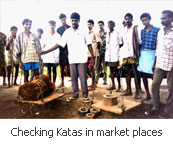 SAKTI developed alternative mechanisms in checking exploitation in markets e.g., by organising weighing balances to the tribal sellers in market places and organized them to bargain for higher prices. SAKTI developed alternative mechanisms in checking exploitation in markets e.g., by organising weighing balances to the tribal sellers in market places and organized them to bargain for higher prices. |
| "About 4000 palm fibre producers gained through the price increase of fibre from Rs two to five. This was due to the palm market influencing done by Sakti, in terms of rate fixing and weighing balances. This is a substantial gain for most tribals, as a typical family works for about 24 weeks during the season and sells about 20-25 kg of fibre per week. Thus, the overall gain to an average family works out of Rs 2400." |
| -Review report of Oxfam, Hyderabad 20-25, Nov’2002 |
| |
| Empowering in the governance of Natural resources: |
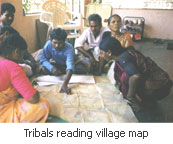 Trained tribal women to argue their cases in the local courts. The training is continuing in land surveys, document verifications, forest management principles. Trained tribal women to argue their cases in the local courts. The training is continuing in land surveys, document verifications, forest management principles. |
| “Out of 26 people trained (by SAKTI) from a dozen villages, 15 learned skills to read village land maps, adangal, field measurement book, and Resurvey Register and can locate the targeted plot in the field. The next step they plan is to decipher title deeds”. |
| -The Hindu, Tuesday, April 6, 1999 |
| |
| Such involvement of tribals in understanding the information procedures of Government and other institutions empowered the tribals to deal with the institutions of revenue, forest, police, judiciary and development agencies. |
• In 1987 officials allowed Sakti to copy the land records.
• In 1997 officials agreed to distribute the land records to tribals
• In 1997 High Court allowed locusstandi of Sakti in court adjudicating land rights.
• In 2001 SERP (Society for Elimination of Rural Poverty) engaged Sakti to train the poor in understanding the land records and identify their problems. |
| |
| Built up a team capable of carrying forward this work of capacity building of tribals. |
| “Sakti’s strength has been a thorough understanding of administrative and legal procedures, which it has used to ensure that tribals derive due and effectual benefits from the law”. |
| - Cyclones in Andhra Pradesh, Oxfam 2000, Page 116. |
| |
 Conducted barefoot land surveyors training for SERP(Society of Elimination of Rural Poverty) in Srikakulam district. Conducted barefoot land surveyors training for SERP(Society of Elimination of Rural Poverty) in Srikakulam district. |
| “It is found that land issue is one of the major areas where poor require lot of support and knowledge base. The whole approach is to build the capacities of poor to secure their rights and entitlements.” |
| - Instructions of CEO,engaging Sakti to train barefoot land surveyors,(SERP) Society for Elimination poverty is having Chief Minister as chair person to channelise world bank loan |
| |
| “(The British) were willing to accept the complaints against the subordinate officials but not against the rules themselves.......... (– Standen, Confidential No.60). [B.P.Standen, Chief Sec. To CC CP 1910].
(They) wanted one person in every household to read and write so that they could explain rules to the rest.” – Debrett, Confidential no.4417. (Officer of Special Duty, Bastar state 1910)
- Nandini Sundar, 1997, Subalterns and Sovereigns . An anthropological History of Bastar, 1854 – 1996. pp.148 & 149; Oxford University Press
|
| |
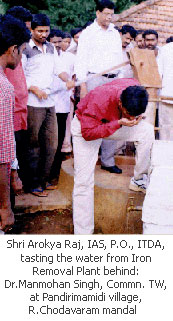 “The seasonal streams and occasional springs supply water for tribals. When the streams dry up in summer the springs are still active and meet the drinking water needs of the people. Borewells are drilled in many villages, but people do not use this water for drinking as the water contain soluble iron, which on exposure make the water coloured and soils the clothes. The springs have to be protected from pollution by the users and from the flood waters during rainy season. Most of the springs are located at the level of the stream bed. Tribals houses settled near the perennial springs occurring at the foot of the hills. The springs need protection by constructing spring boxes to keep the water clean. Tribals can be trained in constructing these spring boxes. Iron removal plants can be attached to all drinking water Borewells to supply Iron free drinking water”. (Technical report of Water Development Society about work of SAKTI to Water Aid) “The seasonal streams and occasional springs supply water for tribals. When the streams dry up in summer the springs are still active and meet the drinking water needs of the people. Borewells are drilled in many villages, but people do not use this water for drinking as the water contain soluble iron, which on exposure make the water coloured and soils the clothes. The springs have to be protected from pollution by the users and from the flood waters during rainy season. Most of the springs are located at the level of the stream bed. Tribals houses settled near the perennial springs occurring at the foot of the hills. The springs need protection by constructing spring boxes to keep the water clean. Tribals can be trained in constructing these spring boxes. Iron removal plants can be attached to all drinking water Borewells to supply Iron free drinking water”. (Technical report of Water Development Society about work of SAKTI to Water Aid)
| |
- Spring Boxes
- Iron Removal Plants
- Hand pump repair
|
| |
|
| |
| Sivaramakrishna was a member of the Regional committee of CAPART, Hyderabad, (Ministry of Rural Development, Govt. of India) 1999-2002. |
| |
| Member of Steering Committee of the UNDP Project on “People’s Empowerment through Panchayat Raj in Schedule V Areas and studies on Laws affecting the poor” convened by NIRD (National Institute of Rural Development). |
| |
| Member of State Board of Wildlife |
| |
| Supporting tribal partnership in forest/ sanctuary management: |
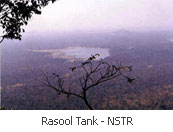 Through public interest litigation, SAKTI enrolled Chenchus of Nagarjuna Sagar – Srisailam Tiger Reserve(NSTR) as voters in Panchayatraj institutions in September 2000. Restored their fishing rights in Rasul tank of NSTR in Mahaboobnagar District. Helped the tribals to obtain orders to notify Chenchu hamlets as revenue villages in the NSTR. Through public interest litigation, SAKTI enrolled Chenchus of Nagarjuna Sagar – Srisailam Tiger Reserve(NSTR) as voters in Panchayatraj institutions in September 2000. Restored their fishing rights in Rasul tank of NSTR in Mahaboobnagar District. Helped the tribals to obtain orders to notify Chenchu hamlets as revenue villages in the NSTR.
| Tribal is born forester. He should become active partner in sanctuary management. |
|
| |
| Developing GIS and MIS for the Tiger Reserve on the basis of Chenchu knowledge. The objective is to enable Chenchus to be knowledgeable partners of tiger sanctuary management. |
| |
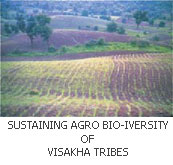 In Vishaka District SAKTI is conducting a study highlighting the Agricultural Bio-Diversity practiced by tribals and helping them to earn more to meet the growing demands through proper management methods. In Vishaka District SAKTI is conducting a study highlighting the Agricultural Bio-Diversity practiced by tribals and helping them to earn more to meet the growing demands through proper management methods.
| Stimulating Agricultural Diversity |
|
| |
| Disaster Preparedness: |
| SAKTI is working extensively in the disaster-affected area of East Godavari delta with special focus on the livelihood of weavers, housing, health, drinking water and sanitation and popularising disaster mitigation education among the school children. |
| "After the 1996 cyclone, the organisation has taken up relief and rehabilitation work along with development. The organisation has adopted an integrated approach on disaster preparedness and relief" |
-Review report of Oxfam, Hyderabad 20-25, Nov’2002
Vulnerable should become capable and secure |
| |
| The encroached drinking water tanks in Dalit hamlets in the Godavari delta are renovated. Now Dalits are learning joint ajmoish to check the appropriation of land and water. |
| "Sakti introduced retrofitting houses in Andhra Pradesh. Now the government is also intending to use this technology for building houses for the weaker sections." |
| -Review report of Oxfam, Hyderabad 20-25, Nov’2002 |
| |
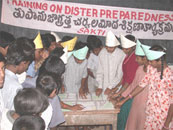 "School Children informed us of their knowledge about disaster preparedness due to the disaster preparedness training introduced in their schools. Among all the other CAP partners, this is a unique programme initiated only by Sakti in India. The curriculum includes topics such as: causes of disasters both natural and man made; flood, cyclones, earthquake; importance of environment protection to reduce natural disaster; Importance of preparing contingency plan and task force groups; government accountability and action taken pre-disaster, namely warning people, shifting people to a safe place, storing food grains, kerosene, water etc. and identifying the most vulnerable groups such as children and the aged, and shifting them in the safe place first. About four hundred children from various schools have already undergone such training." "School Children informed us of their knowledge about disaster preparedness due to the disaster preparedness training introduced in their schools. Among all the other CAP partners, this is a unique programme initiated only by Sakti in India. The curriculum includes topics such as: causes of disasters both natural and man made; flood, cyclones, earthquake; importance of environment protection to reduce natural disaster; Importance of preparing contingency plan and task force groups; government accountability and action taken pre-disaster, namely warning people, shifting people to a safe place, storing food grains, kerosene, water etc. and identifying the most vulnerable groups such as children and the aged, and shifting them in the safe place first. About four hundred children from various schools have already undergone such training." |
| -Review report of Oxfam, Hyderabad 20-25, Nov’2002 |
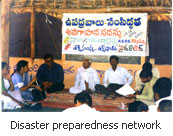 Facilitated the formation of disaster preparedness network of 25 NGOs in Khammam district and trained them in understanding the Godavari flood plan-2002. Facilitated the formation of disaster preparedness network of 25 NGOs in Khammam district and trained them in understanding the Godavari flood plan-2002. |
| |
| AN IDEAL MODEL FOR THE CONSERVATION OF EASTERN GHATS |
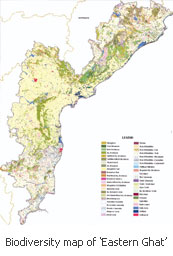 1. Protecting the springs. 1. Protecting the springs.
2. Renovating the tanks irrigated by waterfalls etc.
3. Introducing alternative energy systems.
4. Checking deforestation; Training the forest labourers as skilled workers
5. Restoration of alienated land and checking immigration of non-tribals into tribal areas.
6. Organising the producers to bargain for better price and proper weightment in the markets.
7. Enabling the tribals to get greater command over the administration process of revenue, forest, police and judiciary; nurturing a team of barefoot professionals.
8. Empowering the tribals to strengthen the community management and development practices, to manage the sanctuaries with his traditional knowledge and management systems, exposing them to modern presentation systems (GIS, MIS etc.,)
This looks like a model for conservation of Eastern Ghats!
|
| |